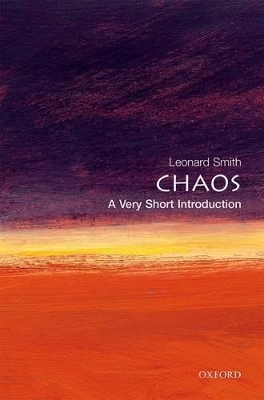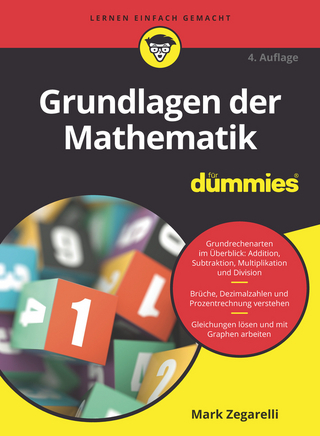
Chaos
A Very Short Introduction
Seiten
2007
Oxford University Press (Verlag)
978-0-19-285378-3 (ISBN)
Oxford University Press (Verlag)
978-0-19-285378-3 (ISBN)
Chaos exists in systems all around us. This introduction draws in philosophy, literature, and maths to explain Chaos Theory, showing the variety of its applications in the real world, from technology to global warming, politics, and even gambling on the stock market.
Chaos exists in systems all around us. Even the simplest system of cause and effect can be subject to chaos, denying us accurate predictions of its behaviour, and sometimes giving rise to astonishing structures of large-scale order. Our growing understanding of Chaos Theory is having fascinating applications in the real world - from technology to global warming, politics, human behaviour, and even gambling on the stock market.
Leonard Smith shows that we all have an intuitive understanding of chaotic systems. He uses accessible maths and physics (replacing complex equations with simple examples like pendulums, railway lines, and tossing coins) to explain the theory, and points to numerous examples in philosophy and literature (Edgar Allen Poe, Chang-Tzu, Arthur Conan Doyle) that illuminate the problems. The beauty of fractal patterns and their relation to chaos, as well as the history of chaos, and its uses in the real world and implications for the philosophy of science are all discussed in this Very Short Introduction.
ABOUT THE SERIES: The Very Short Introductions series from Oxford University Press contains hundreds of titles in almost every subject area. These pocket-sized books are the perfect way to get ahead in a new subject quickly. Our expert authors combine facts, analysis, perspective, new ideas, and enthusiasm to make interesting and challenging topics highly readable.
Chaos exists in systems all around us. Even the simplest system of cause and effect can be subject to chaos, denying us accurate predictions of its behaviour, and sometimes giving rise to astonishing structures of large-scale order. Our growing understanding of Chaos Theory is having fascinating applications in the real world - from technology to global warming, politics, human behaviour, and even gambling on the stock market.
Leonard Smith shows that we all have an intuitive understanding of chaotic systems. He uses accessible maths and physics (replacing complex equations with simple examples like pendulums, railway lines, and tossing coins) to explain the theory, and points to numerous examples in philosophy and literature (Edgar Allen Poe, Chang-Tzu, Arthur Conan Doyle) that illuminate the problems. The beauty of fractal patterns and their relation to chaos, as well as the history of chaos, and its uses in the real world and implications for the philosophy of science are all discussed in this Very Short Introduction.
ABOUT THE SERIES: The Very Short Introductions series from Oxford University Press contains hundreds of titles in almost every subject area. These pocket-sized books are the perfect way to get ahead in a new subject quickly. Our expert authors combine facts, analysis, perspective, new ideas, and enthusiasm to make interesting and challenging topics highly readable.
Leonard Smith is Senior Research Fellow in Mathematics at the University of Oxford, where he lectures on nonlinear dynamical systems and chaos.
Preface ; 1. The Emergence of Chaos ; 2. Exponential Growth, Nonlinearity, Common Sense ; 3. Chaos in Context: Determinism Randomness and Noise ; 4. Chaos in Mathematical Models ; 5. Fractals, Strange Attractors, and Dimension(s) ; 6. Quantifying the Dynamics of Uncertainty ; 7. Real numbers, Real Observations and Computers ; 8. Sorry, Wrong Number: Statistics and Chaos ; 9. Predictability: Does Chaos Constrain Our Forecasts? ; 10. Applied Chaos: Can We See Through Our Models? ; 11. Philosophy in Chaos ; Glossary ; Further Reading
| Reihe/Serie | A Very Short Introduction |
|---|---|
| Zusatzinfo | 30 halftones and line drawings |
| Verlagsort | Oxford |
| Sprache | englisch |
| Maße | 111 x 174 mm |
| Gewicht | 168 g |
| Themenwelt | Sachbuch/Ratgeber ► Natur / Technik |
| Mathematik / Informatik ► Mathematik ► Allgemeines / Lexika | |
| Mathematik / Informatik ► Mathematik ► Angewandte Mathematik | |
| Mathematik / Informatik ► Mathematik ► Geschichte der Mathematik | |
| ISBN-10 | 0-19-285378-3 / 0192853783 |
| ISBN-13 | 978-0-19-285378-3 / 9780192853783 |
| Zustand | Neuware |
| Haben Sie eine Frage zum Produkt? |
Mehr entdecken
aus dem Bereich
aus dem Bereich


